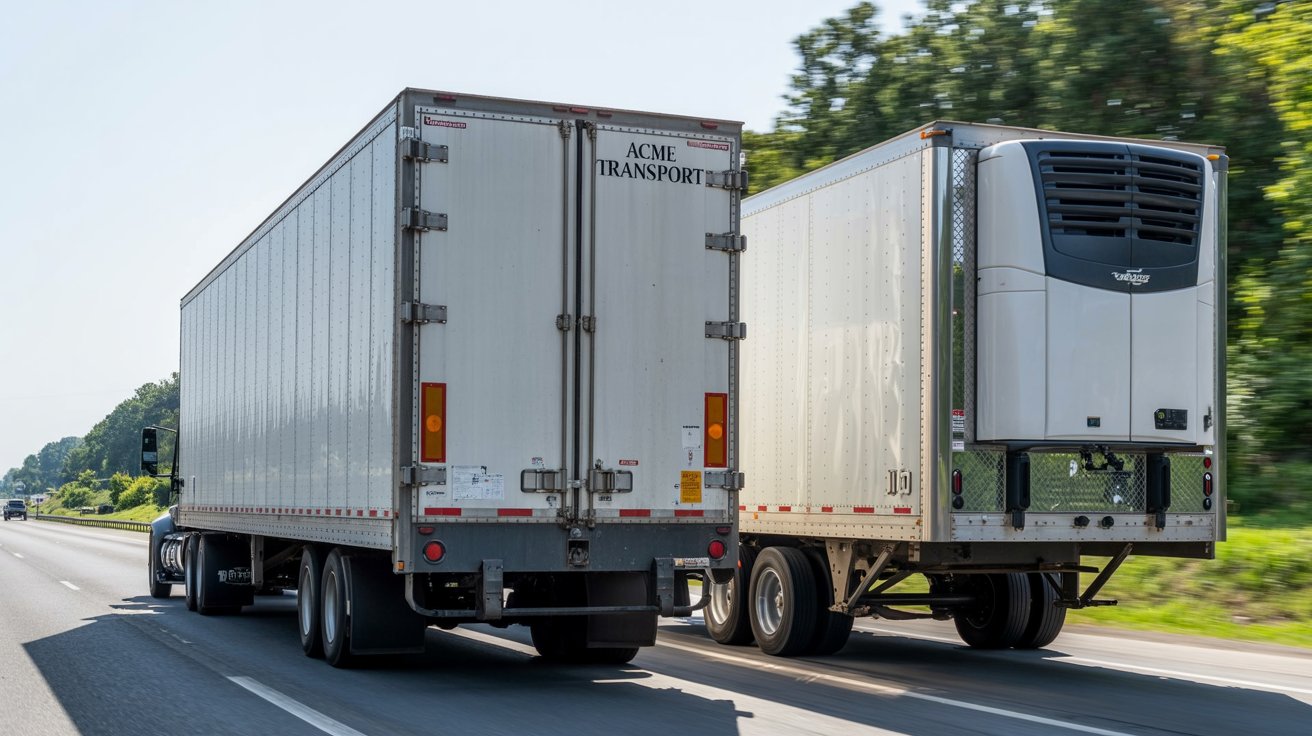Dry Van vs Reefer: Key Differences, Costs, and Best Uses Explained

Introduction
When it comes to freight transportation, one of the most common debates is dry van vs reefer. Both trailer types dominate the trucking industry, but they serve very different purposes. Dry vans are the backbone of general freight movement, handling everything from electronics to packaged foods. Reefer trailers, on the other hand, are essential for temperature-sensitive cargo such as produce, meat, and pharmaceuticals.
If you are a shipper trying to choose the right trailer for your products—or a carrier deciding which type of equipment offers the best return on investment—understanding the differences between dry van and reefer is critical. This guide breaks down their features, costs, risks, and best uses so you can make informed decisions.
What Is a Dry Van Trailer?
A dry van trailer is the most common type of enclosed trailer on the road. Typically 53 feet long, these trailers are fully enclosed boxes with no refrigeration or climate-control system. They are designed to keep goods safe from external elements like weather, dust, and theft.
Shippers rely on dry vans to move non-perishable products such as furniture, consumer goods, paper, clothing, and electronics. Because dry vans are widely available, they are often the most affordable and flexible option for freight transport. However, they lack temperature control, making them unsuitable for perishables or goods requiring strict climate conditions.
What Is a Reefer Trailer?
A reefer trailer—short for refrigerated trailer—adds an insulated body and a refrigeration unit to a standard trailer. These trailers can cool, heat, or maintain goods at a consistent temperature throughout the trip. Depending on the cargo, reefer units can be set anywhere from deep freeze to controlled ambient temperatures.
Reefers are indispensable for industries like agriculture, food and beverage, pharmaceuticals, and chemicals. They allow carriers to move fragile, high-value, and temperature-sensitive cargo safely. However, they come with higher costs due to fuel consumption, equipment maintenance, and specialized handling procedures.
Dry Van vs Reefer: Key Differences
Temperature Control
The most obvious distinction in the dry van vs reefer debate is temperature. Dry vans provide no climate regulation—they move freight at whatever the outside temperature may be. Reefers, on the other hand, maintain precise conditions, whether the load requires freezing cold, gentle cooling, or even heat. This makes reefers suitable for produce, frozen foods, and medicines that must not deviate from set points.
Cargo Compatibility
Dry vans are best for general freight—goods that do not spoil or require special handling. Meanwhile, reefers transport perishables like meat, dairy, produce, and sensitive goods like vaccines or cosmetics. Reefers can technically haul dry freight, but it is rarely cost-effective unless paired with a backhaul.
Weight & Capacity
Both dry vans and reefers are commonly 53 feet long, but payload capacity differs. Because reefers include insulation and a refrigeration unit, they weigh more and can carry slightly less cargo compared to a dry van. This difference matters when transporting heavy loads that approach the trailer’s legal weight limit.
Operating Costs
Dry vans are relatively low-cost to operate. They require basic maintenance and no extra fuel beyond the tractor. Reefers, by contrast, burn additional fuel to power the refrigeration unit, and they need more frequent service to keep compressors, belts, and evaporators in working condition.
Freight Rates & Demand
In the dry van vs reefer comparison, rates vary with demand cycles. Dry vans typically offer steady but lower-paying freight. Reefer rates tend to spike during harvest seasons or holidays when food distribution peaks. Carriers operating reefers can often command higher revenue but must balance it against higher expenses.
Compliance & Documentation
Dry van shipments rarely involve special compliance. Reefers, however, require strict records such as temperature logs, seals, and sometimes regulatory inspections, especially when moving food or pharmaceuticals.
Cost Breakdown: Dry Van vs Reefer
Purchasing a new dry van trailer is far cheaper than investing in a reefer. While a dry van may cost $35,000 to $60,000, a reefer can easily exceed $100,000 due to its advanced equipment.
Operational expenses differ as well. Dry vans mainly incur tire, brake, and suspension maintenance, while reefers add refrigeration unit servicing, fuel costs for the unit, and increased insurance premiums. Over several years, the total cost of ownership for a reefer can be nearly double that of a dry van, even before factoring in unexpected repairs.
Revenue and Profitability
For carriers, profitability depends on utilization. A dry van may generate consistent but moderate income, while a reefer has higher earning potential if operated efficiently. Reefer carriers can take advantage of seasonal rate spikes in produce or holiday food shipments. However, poor planning—such as excessive deadhead miles or underutilized reefer units—can quickly erode profits.
Risk and Quality Control
Risks also differ significantly. Dry vans face risks like load shifting, moisture damage, or theft, but these are manageable with proper securement and inspection. Reefers must contend with strict temperature compliance. A single malfunction, door left open too long, or incorrect set point can result in a rejected load worth thousands of dollars. Carriers must maintain meticulous logs and equipment checks to minimize claims.
Technology in Dry Van vs Reefer Operations
Technology is transforming both trailer types. Dry vans now benefit from GPS tracking, door sensors, and load monitoring. Reefers are even more technology-driven, often equipped with remote temperature control, data logging, and real-time alerts. These systems help prove compliance, reassure shippers, and reduce claim risks.
Industry and Regulatory Requirements
For dry vans, compliance is minimal beyond standard safety checks. Reefers, however, must follow food safety laws and pharmaceutical transport regulations. Carriers often face audits and must show temperature records to prove goods remained within safe ranges. Failure to comply can damage a carrier’s reputation and result in financial losses.
When to Choose a Dry Van
A dry van is the best choice if your cargo is stable at ambient temperature, your budget is limited, or you want faster turnaround and broad availability. Dry vans are perfect for consumer goods, packaged foods, household items, and electronics.
When to Choose a Reefer
A reefer is necessary when transporting perishables, sensitive chemicals, or high-value goods requiring climate control. Reefers are also more versatile, as they can move both temperature-sensitive and dry freight if needed. However, the added flexibility comes with higher costs.
Decision Checklist
When comparing dry van vs reefer, ask:
- Does my cargo require temperature control?
- What are my lane demands and seasonal patterns?
- Can I afford higher fuel and maintenance costs for a reefer?
- Do my facilities support reefer loading procedures?
- What compliance records must I maintain?
- Will technology investments help secure better contracts?
Best Practices for Each Trailer Type
For dry vans, best practices include proper load securement, bracing, and moisture control. For reefers, it is critical to pre-cool trailers, set accurate temperatures, limit door-open times, and regularly clean and sanitize. Both types require routine inspection to avoid delays and claims.
Common Mistakes to Avoid
Shippers often misjudge the type of trailer needed. Using a dry van for cargo that should be temperature-controlled can lead to costly spoilage. On the reefer side, mistakes include incorrect temperature settings, ignoring airflow requirements, or failing to document compliance properly.
FAQs
Can a reefer haul dry freight?
Yes, but it is less cost-efficient unless used as a backhaul.
What temperature ranges do reefers cover?
Reefers typically operate between -20°F and +70°F.
How much fuel does a reefer burn?
Around 0.5 to 1 gallon per hour, depending on conditions.
Do reefers need special insurance?
Yes, due to higher cargo risk.
What proof is needed for compliance?
Temperature logs and seal records are standard.
Final Takeaway
The debate of dry van vs reefer comes down to cargo needs, cost structure, and operational goals. Dry vans offer affordability, wide availability, and simplicity for general freight. Reefers provide versatility and premium rates for sensitive goods but at a significantly higher cost.
For shippers, the decision ensures cargo safety and cost-efficiency. For carriers, it can determine profitability, reputation, and long-term business success. By carefully weighing the differences and applying best practices, you can confidently choose the trailer type that best fits your freight and budget.
Do Read: Las Vegas Taxi from Airport: The Ultimate 2025 Guide for Travelers







